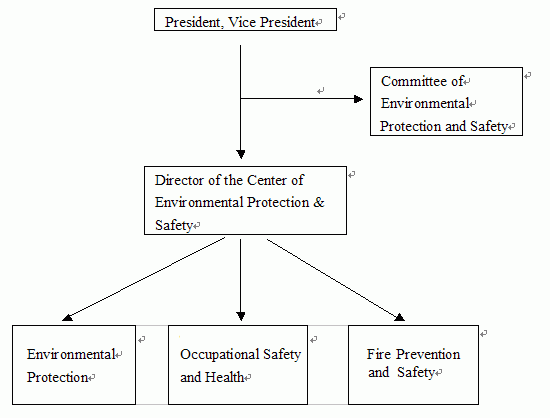 Brief Introduction to the Center of Environmental Protection & Safety of National Central University
Brief Introduction to the Center of Environmental Protection & Safety of National Central University
 Purpose of Establishment
Purpose of Establishment
I. To Establish a Perfect Management for Campus Environmental Protection and Safety
Laboratories and training factories on campus are meant to provide professors and students an opportunity to carry out the verification of theories. In Taiwan most of these training places located on college campuses lack organizations that can supervise the maintenance of safety and health, and also lack environments with unified duties and responsibilities. This is the reason why accidents have happened in recent years throughout Taiwan: graduate student working late into the night killed from accidental taking of toxic substance, undergraduate electrified to death during experimental procedure, accidental toxic outflow of experimental chemicals, laboratorial fire accidents……. All these incidents point to the negligence of environmental and safety education and emergency training. For all the causes above, we find that it is essential to establish a center with the duty to prevent similar accidents from occurring, and through the regulations and administrative measures of this center, students at NCU are able to attain a thorough and correct concept of disaster prevention, environmental protection and safety, and hopefully to carry out the same concept in their future works in the society.
II. Fulfilling the Regulations of National Decrees
1. The Laborers' Law of Safety and Health was established in 1974, and revised in 1991. It mainly aims at preventing job calamity and ensuring labor workers' safety and health. The Council of Labor Affairs in the Executive Yuan, in December of 1993, according to the 15th rule of item 1 of the fourth article of the Laborers' Safety and Health Law, along with item 2 of the same article, appointed that the Labors' Safety and Health Law is applied to laboratories and training factories of colleges all around Taiwan.
2. According to item 2 of article 2 of “the laborers' safety and health organization management and automatic inspection method”, management unit should be the direct unit under the institution or company, and according to article 3, specialized relative administrative staffs should be assigned.
3. Article 21 of the Law of Prevention and Treatment of Water Pollution, and item 2 of article 16 of the Law of Toxic Chemical Material Management both dictate that specialized unit and personnel for environmental protection should be constituted.
4. Fire Protection Law.
5. Article 2 of the Establishing rule of environmental protection group of educational administrative organizations and affiliated schools and institutions: for the purpose and task of promoting campus environment and environmental education, assignment-oriented environmental protection group should be set up at all levels of school. Comprehensive environmental protection center or environmental education center should be formally organized in case of necessity. Institutions of various levels in charge of educational administration should follow the statements above.
 Direction of Development and Function
Direction of Development and Function
I. Direction of Development
1. Collection of information in industrial safety, and environmental protection, which leads to the construction of a professional website which provides searching engines and links for related material, and which every unit in NCU can have access to. This way other universities and schools are also able to surf and share the resources correlated to environmental protection in NCU, which contributes to the improvement of the reputation of NCU.
2. Cooperation with the Research and Development Office, the General Affairs Office, Institute of Environmental Engineering and the Department of Chemical and Materials Engineering to open up the safety, health and relative license training course in this area, which raises financial funds, and offers a way for workers from industrial sectors to study.
3. To propel the cooperation and communication of regional environment development, education in occupational safety and health, and development in research.
4. Management, assessment, inspection and suggestion of natural calamities on the campus and fire safety equipments of buildings.
5. Environmental impact assessment of campus construction engineering, and review and proposition of safety equipment in building plans.
6. Coordination, supervision and control of pollution, public water hygiene and waste material treatment on the campus.
7. The planning and supervision of improvement in campus environmental quality.
8. Prevention of occupational calamities, planning and direction in the guarantee program for health and safety of students and faculty.
9. The training of students to possess accurate and correct concepts on calamity precaution and environmental protection, which will contribute strongly and widely to the society after students' graduation.
10. Training of qualified teachers for the special course on environment protection and industrial safety.
II. Goal of Function
The establishment of this center contributes to the unification of the relevant duties and responsibilities of NCU. On enthusiastic means, it helps to precisely carry out the management of environmental protection, safety and prevention. Furthermore it ensures the safety and health of students and faculty. On passive means, it assures the achievement of statutory responsibilities, and prevents NCU from penalties from relative authorities of the government.
 Framework of the Organization
Framework of the Organization

 Occupational Activities of Each Area
Occupational Activities of Each Area
I. Occupational Safety and Health
1. To conclude annual occupational calamity prevention plans and regulations:
The establish of plans and regulations that are in accordance with the actual demands of the school, and which are in suitable needs for the faculty, research assistants, graduate students, and all students related, and which are to be followed by all.
2. To construct a smoothly operated organization of safety and health:
a. Unit of safety and health management for laborers
b. Committee of safety and health management for laborers
3. To conduct statutory education and training of safety and health:
Conduct the general education and training on safety & health, the training of personnel for special working areas, the general education for emergency measures, and preparation for receiving licenses on operating dangerous machinery.
4. To set up a working environment that matches safety and health standards:
The control and superintendence of physical, chemical, biological endangering factors, protection measures for machines that reach statutory protection levels( wash cutting machine, piling machine, grinding machine, etc.) , regular checkup of dangerous mechanical equipment (boiler, pressure container, high-pressure gas container, lift, hoist, etc.), clear indication and points of attention for hazardous items, and environmental tests (on organic solvents, specific chemical materials, dust, noise, etc.) directed against operational areas.
5. Guidance to laboratories of every unit to set up safety and health administration systems:
Help laboratories to set up automatic inspection systems, and draw up plans for standard operation of experimental facilities, and offer consultation for work improving methods. (Automatic inspections should be carried out by superintendent personnel.)
6. To conduct annual health examinations:
Conduction of regular health examinations and physical checkups, along with the preparation of first-aid materials and assignment of first-aid personnel.
7. The implement of accident investigation and analysis when needed, and filling out of monthly reports of occupational calamities.
8. Offer suggestions on safety and health management to every laboratory director.
9. Other relevant items in management of safety and health.
II. Environmental Protection
i. Prevention of air pollution
1. Collate air pollution prevention and improvement plans, and coordinate related departments and centers.
2. Supervise the normal operation of air pollution preventing measures, and reserve all relative information.
3. Draw up plans for emergency measures of sudden accidents, and bring them into coordinative practice.
4. Handle permissions for the setting up, changes and operations of regular pollution sources, and supervise its permission in continuous operation.
5. Supervise and examine the discharge of air pollutants through waste channels, reserve related analyzed data, and report information on these pollution sources to related government authority.
6. Other relative items in management of air pollution.
ii. Prevention of water pollution:
1. Collate improvement plans on collection and handling of used (waste) water.
2. Help NCU to lighten the quality and quantity of pollution sources, supervise the measures on prevention and control and report the supervision results and suggestions on pollution improvement and management to the center director.
3. Help different departments to manage and maintain regular operation of waste disposing devices, and note down results on maintenance.
4. Carry out quality and quantity measurements on used (waste) water.
5. Draft and coordinate the implementation of emergency measures during the breakdown of waste disposing devices, and report correlated malfunction records to higher authorities.
6. Management on release ends of waste water.
7. The declaration and other related reports on waste water treatment, all based on the Law on the Prevention and Treatment of Water Pollution.
8. Coordinate with the Office of General Affairs and the Office of Student Affairs on public drinking water hygiene management.
9. Other related items in management of water pollution.
iii. Management of toxic chemicals and wastes:
1. According to article 11 of the Law on Treatment of Toxic Chemical Materials, apply for permission, check and register the condition of operation, and deal with the prevention of danger and pollution of toxic chemical materials.
2. Help in managing toxic chemical materials: prevent its quantity from being deficient and excess loss in the environment; manage and maintain the disposing utility, emergency equipment and alarming devices; supervise the maintenance and checkups, and noting down the results.
3. Help with the execution of emergency measures when the environment or health conditions of personnel become endangered by pollution; also, in accordance with item 2 of article 22 of the Law on Treatment of Toxic Chemical Material, help authorities with the clearing up and investigation after the happening of accidents.
4. Help NCU to establish emergency measures and emergency accident systems on toxic chemical materials.
5. Operation of toxic and radioactive chemical materials, along with the report and management on release amounts.
6. Assist the decrement in release of toxic chemicals, and the improvement in related equipment, and carry out operation management plans.
7. Other related items in management of toxic chemicals and wastes.
iv. Management of waste discarding:
Manage the transporting, handling and pollution prevention of discarded wastes.
III. Fire Prevention and Safety
i. The duties of administrative personnel in means of fire prevention
(the president or other authorities who have right to administrate):
1. Responsible for the careful selection of fire prevention caretakers, which in turn should promote and manage fire prevention activities.
2. Guidance and supervision required for administrative personnel to proceed.
3. Declaration of fire prevention plans.
4. Supervision in the checking and maintenance of fire safety devices.
5. Establish coordinative fire control and prevention programs along with all related departments.
6. Offer essential instructions of fire prevention plans when changes of the plans are made.
7. Declare the selection and dismissal of fire prevention caretakers.
ii. The duties of caretaking personnel in means of fire prevention
(appointed by the administrative personnel):
1. The establishment, review and modification of NCU fire prevention plans.
2. Guidance and supervision of the usage of electricity and fire within the school.
3. Supervision and inspection of dangerous articles and relevant facilities.
4. Safety supervision of electric equipment, electric cable lines, machinery and fire using equipment.
5. Supervision and inspection of fire safety devices.
6. Accident notification, the action of putting out fires and the training of fire safety drills.
7. Offer advice to and get instructions from administrative personnel.
8. Help different departments to carry out the self-check and management of fire prevention and emergency devices.
9. Other related items in precautionary measure of fire prevention.
iii. Emergency measures and precaution steps of natural calamities
